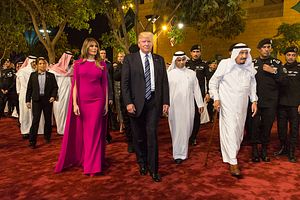As U.S. President Donald Trump concluded his visit to the Middle East, speculation has been growing that his calls for a united front with the leadership of Arab states in combating extremism in the region is an indirect reference to Iran’s sponsoring of militancy in the region.
Trump’s speech in Riyadh specifically mentioned Hezbollah, Hamas, and ISIS, of which the former can be construed as a reference to Iran promoting instability in the region. This policy of promoting unity between the members of the GCC coalition, the United States, and countries with predominantly Sunni populations does send ominous signs that cannot be limited to Iran and curbing its influence alone.
This pivot in Washington to the Arab states of the Middle East and its focus on combating terrorism and promoting economic cooperation came shortly after the Belt and Road Forum in Beijing. There have been repeated calls by China to integrate east and west Asia — calls which were met with great applause and hope. Of those invited from the region, India, which shares a strong bilateral relationship with the United States, was notably absent. (Washington sent a delegation.) This said, the initiative was hailed by Moscow, Beijing, and Islamabad as a shift of momentum from the west to the east, where economic connectivity runs parallel with China’s economic rise and poses a potent challenge to the Trump administration.
There are various strategic rationales that explain China’s OBOR initiative. For example, hardcore realists would argue that corridors such as CPEC would allow China to gain access to the oil rich Gulf region. Geographically, the port of Gwadar in Pakistan is an ideal conduit to realize this objective. It is also noteworthy that China and Saudi Arabia had signed a monumental deal worth $65 billion, which focuses on trade and cooperation and hints at Beijing’s desire to gain greater ingress in a region that has traditionally been defined by the competing interests of the United States and Iran.
U.S. allies, which include the UAE, Saudi Arabia, Qatar and Kuwait, presently constitute a security umbrella. Hence, China pressing for multiple corridors and gaining access to the gulf markets in the Middle East may pose a challenge to U.S. economic interests where the promotion of free market economies and gaining access to oil resources has been a salient feature of its foreign policy.
That said, the convening of a counterterrorism center and explicit calls for reigning in extremism, means that this Arab- Islamic-American summit can be construed as a security corridor with some observers considering this initiative as an ‘Arab NATO’. While this certainly is true given the optics, the policy of containing China given the timing of the summit coinciding with the recent conclusion of the Belt and Road Forum in Beijing cannot be completely dismissed.
Under Trump, the slogan of “Making America Great Again” has been a rallying cry to revive the U.S. as an economic superpower and while the Trump administration is expected to pursue protectionist policies domestically, ensuring that economic interests are secured abroad is an equal priority. For that to happen, however, containing China’s rise through bilateral economic deals is essential. A region as fertile as the Middle East and so intertwined historically with the United States should be treated as no exception.
Hamzah Rifaat was a 2016 South Asian Voices Visiting Fellow at the Stimson Center and has represented Pakistan as a member of the CTBTO Youth Initiative of 2016 in Vienna.

































